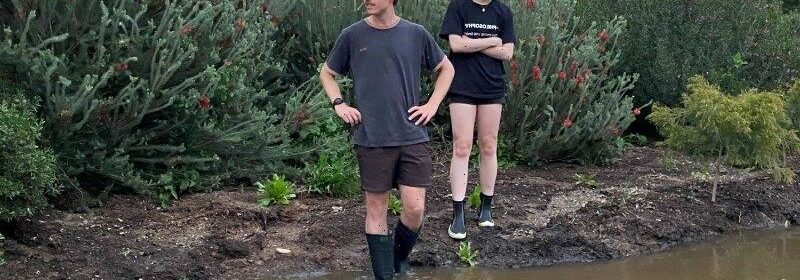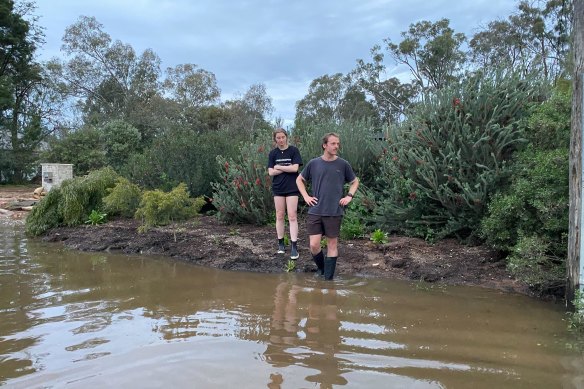Climate change is someone else’s problem, until it laps at your door

Our live coverage of the extreme weather is free for all readers. Please consider supporting our journalism with a subscription.
Last September I returned home to help mum plant an avenue of pear trees. It was tough going, using a crowbar to bore out holes in the dry clay ground. Once we had finished and the sun was setting over the red gums, we sat back with a beer and admired our work. Mum put her arm around me and said something like “I can already imagine the grandkids riding their bikes through the trees”.
“No pressure, though,” she was quick to add.
On my most recent visit to Echuca, last week, we wore gumboots and had to wade in through water up to our knees.
Five days earlier, my mum and sister packed their bags and fled the house just hours before the Campaspe River broke its banks, overwhelming sandbag levees and submerged pumps on its way to our home.
When the water subsided enough to let us in, what we found was a crime scene created by an unrelenting intruder. The river broke in through the back door and seeped in under the swollen floorboards. It pooled sand and debris in the corners, turned plaster into mush, and carried pot plants halfway across the house.
Outside, the permanent levee banks designed to protect our home were gone, eroded by the sheer force of the fast-flowing water. Those pear trees were leaning slightly, as if already anticipating the next flood.
This year, my first as a full-time journalist, I have interviewed people who’ve had their homes wiped out by successive floods. I’ve live-blogged evacuation orders and written stories alongside photos of the devastation inflicted on communities like Lismore, Richmond and Camden.
None of it prepared me for this moment, standing in the wreckage of my family home.
With my sister Greer outside our flooded home in Echuca, on the border of Victoria and NSW.Credit:
Other journalists were interviewing our neighbours, filing stories and filming pieces to camera around the corner from our street. But the scale of what had just happened to us didn’t really hit home until days later, when I logged on to the Herald to find aerial photos of my own home submerged in floodwater.
The question I ask myself now is one an increasing number of people across Australia and the world are also asking: did the climate crisis cause our house to flood?
The first thing to acknowledge is that flooding is part of the natural cycle of our river systems, and it is reasonable to expect houses built on floodplains to go under from time to time. Local governments have tightened planning regulations to limit the damage, and the NSW state government’s $800 million buyback scheme is one example of the huge financial, social and emotional cost of previous planning mistakes.
But plans are based on previous flood levels, and the climate crisis is throwing precedent out the window. Australia’s weather breaks its own records as often as our Olympic swimmers. The intensity of extreme rainfall events has increased by about 10 per cent in some parts of Australia, according to the Climate Council.
Climate change increases the chances of a flood occurring in any given year, and reduces the amount of time communities have to recover in between. Last month’s flood was Echuca’s largest in more than 150 years.
River communities are dealing with the immediate reality of the clean-up, knowing more floods are most likely just around the bend. Most of Echuca was spared, largely thanks to a mammoth levee-building effort, but communities such as Rochester in Victoria and Lismore in NSW will take longer to heal.
Flooding disproportionately affects poorer and marginalised communities because houses built on floodplains are typically worth less, while more-established and affluent households tend to settle on higher ground. This inequality is global; devastating flash flooding across Pakistan, Sri Lanka and India this year has claimed more than a thousand lives and caused billions of dollars of damage to already fragile economies.
This year marks 35 years since the landmark Greenhouse ’87 conference, where scientists predicted with remarkable foresight that citizens and governments would only act once people could see the effects of climate change on their daily lives.
That hunch was prophetic, and that moment is now.
Our family and hundreds of others across Australia will face tough decisions in the coming months and years, but so will policymakers and voters in cities yet to directly witness the climate crisis firsthand.
I dearly want mum to be able to watch her grandkids ride through that avenue of pear trees. The question is, at what cost?
The Opinion newsletter is a weekly wrap of views that will challenge, champion and inform your own. Sign up here.
Most Viewed in Environment
From our partners
Source: Read Full Article
